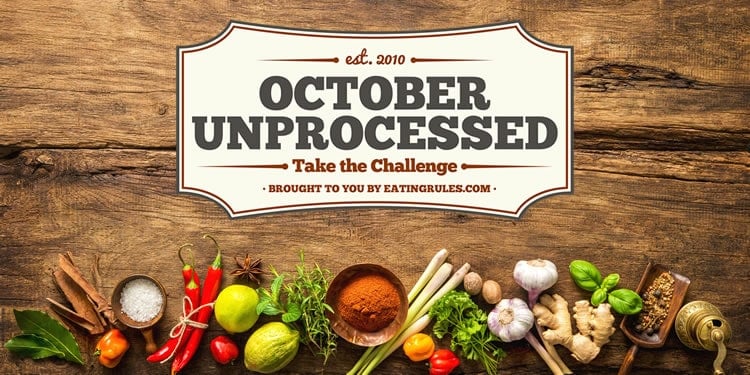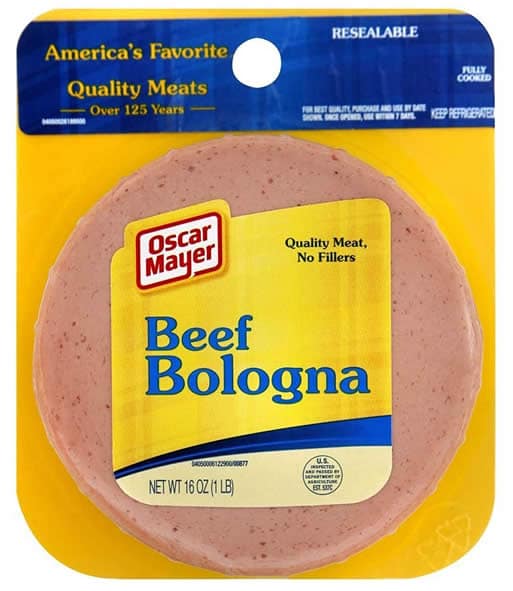Unprocessed FAQ: The Kitchen Test
Sep 20, 2019

We’re just a couple of weeks away from the start of the October Unprocessed challenge! If you haven’t taken the pledge yet, please check it out and then come back here and keep reading.
I get asked a lot of questions about how to define “unprocessed,” and how my definition applies to specific ingredients and foods. I’ve previously published a series of Frequently Asked Questions posts – I’ll be re-publishing them over the next few weeks to bring them to the top of the pile and help everyone prepare for this year’s challenge.
The Kitchen Test
Because there are always so many questions about how to apply my “Kitchen Test,” let’s take a quick look at it:
Unprocessed food is any food that could be made by a person with reasonable skill in a home kitchen with whole-food ingredients.
The Kitchen Test is how I define “unprocessed.” It works well for me, and many people find it works well for them, too. But it may not fit with your definition of “unprocessed,” and that’s totally okay. In fact, I encourage disagreement and discussion, since that’s the best way for us to learn together.
I also recognize that the Kitchen Test isn’t perfect. My goal here isn’t perfection – it’s more to spark a dialogue, increasing awareness about how our food is made, what we’re putting into our bodies, and how we relate to our food.
Whole-Food Ingredients
The Kitchen Test doesn’t mean that you have to make the food. Nor does it mean that you necessarily need to be able to make the food (you don’t have to be Julia Child!). It just requires that the food could be made in a home kitchen by someone who knows what they’re doing, using whole-food ingredients.
So we also have to define “Whole-Food Ingredients.”
I start by trying to figure out if I could grow/create/produce that ingredient at home, at least in theory. If the answer is yes, then it’s good to go. But if it’s made through an industrial or complicated chemical process that couldn’t be done in a kitchen (however you define “kitchen”), or could only be made “in a laboratory,” then it’s out.
The big idea, ultimately, is to consider each ingredient in your food: How it’s produced, where it comes from, and whether its benefits outweigh its detriments.
We’ll talk more about specific ingredients over the next few weeks, but in the meantime, just remember that anything you could make at home, from ingredients that you could produce at home, will pass the test.
Packaged Foods
While cooking from scratch is obviously the ideal choice, it’s not always feasible or practical. Most people (myself included!) are not going to prepare everything from scratch, especially if you’ve got a job, school, kids, pets, or are traveling…
So what to do when you buy packaged food? The answer is simply to consider every ingredient separately.
My favorite example is comparing two “energy bars.” Here are the ingredients for the PowerBar Protein Plus Chocolate Peanut Butter:
trisource protein blend (soy protein isolate, calcium caseinate, whey protein isolate), maltitol syrup, chocolate flavored coating (sugar, fractionated palm kernel oil, cocoa, whey, nonfat milk, soy lecithin, natural flavor), oligofructose (from chicory root), fructose, water, cane invert syrup, peanut butter, partially defatted peanut flour, soy crisps (soy protein isolate, rice flour, salt), peanut oil, and less than 2% of: salt, ground almonds, natural flavor, soy lecithin, butter (cream).
I’ve bolded any ingredients that I’m pretty sure you can’t make at home (some of these might be debatable, but I’ll leave that for the next few posts). Compare that to the ingredients of a Cashew Cookie Larabar:
cashews, dates.
I’m absolutely certain that a person with average skills could make something comparable to the Larabar in his or her kitchen. But the PowerBar? Not so much.
(Since I originally wrote this post, General Mills bought Lara and started introducing new varieties — including “natural flavors” in some of them. The “Uber” bars also used brown rice syrup, which is a concentrated sugar that you probably couldn’t make at home. However, they’ve since “retired” the Uber bars, and it looks like most of their products once again pass the Kitchen Test. Since last year, though, they introduced a “Protein” line that includes pea protein, so those wouldn’t pass the test.)
Restaurant Foods
Eating out is probably the hardest part of the challenge. Since you don’t know the ingredients, you just have to do the best you can. Some dishes are more likely to pass the kitchen test. Here are some strategies I use — if you have other suggestions, please share them in the comments:
- Talk to your waiter. It’s totally okay to tell your waiter that you’re eating only unprocessed food, and ask him or her questions about the food they serve. You’re about to put it in your body – you have every right to know what it is. If the waiter doesn’t know, ask to speak with the Chef. Just remember to be friendly and polite.
- Avoid large, chain restaurants. They often have lots of additives, stabilizers, conditioners, and preservatives in their foods (since they’re rarely made fresh). Obviously that’s a generalization, but you’re usually better off at a small, family- or chef-owned restaurant.
- Find a local, “farm to table” restaurant, if you can. More and more like-minded restaurants are popping up all over the country, so seek them out… and let them know about the challenge!
- A Fresh Salad is usually a good choice. It’s the dressing you’ve got to watch out for. A good choice is Olive Oil and Balsamic Vinegar, both of which pass the Kitchen Test.
- Pasta may pass the test — if it’s made with unbleached, unenriched flour (if you can find 100% whole wheat pasta at a restaurant, you’ll be in good shape). Then you just need to ask about the ingredients in the sauce. Olive oil and garlic, anyone?
- Cooked Vegetables usually work well.
- If you eat meat, that’s usually a good choice, depending on how it’s prepared. (Again, watch the sauce.)
- Tofu and tempeh usually pass the kitchen test. (Seitan is a gray area… You could make seitan at home from wheat flour, but at the commercial level it’s usually made with vital wheat gluten).
The Deliberate Exception Clause
I encourage you to consider exceptions, if any, you will make to your definition of unprocessed. The idea is to decide on any exceptions before we start, if possible. It’s not there for you to use your exceptions as a way to cheat in the moment. Instead, it’s about making an informed decision, in advance, about a particular food.
For example, Matty and I have decided that Vital Wheat Gluten is an acceptable ingredient for us, because we’d rather eat whole grain bread (preferably baked ourselves) that is made with some extra gluten, than to eat bread made with refined grains. We carefully considered it in advance, and decided that the “pros” outweighed the “cons.”
It’s also okay to make an exception for something you feel you need to do to make it possible for you to complete the challenge at all. For example, maybe you’re a five-cans-of-soda-a-day person (like I once was), and have decided that for October, you’re going to limit yourself to just one can of soda each day.
Remember that this is fundamentally an awareness exercise, and ultimately, you need to do what’s right for you, and what’s going to work for you.
If you haven't taken the October Unprocessed pledge yet, please do! And then encourage your friends to join in -- it's a lot more fun that way!






















I’m doing great per this read..for years I try to live like grandma did. ?.what would she have found in the stores..or grew herself..she had livestock too..Eating out is the challenge.
The single hardest exceptions to give up are salt and Sriracha. But I like your ideal and strive toward it.
Hi Sarah – Would you believe that you don’t have to give up salt or sriracha? Although the storebought Sriracha doesn’t pass the test (they add preservatives), you could easily make your own!
https://eatingrules.com/homemade-sriracha/
Or, if you don’t want to bother, the Original Tabasco sauce actually passes the kitchen test. I know it’s not the same, but it’s still spicy!
As for salt – you could make sea salt yourself, too:
https://eatingrules.com/how-to-make-sea-salt/
Sarah, i bought a bunch of tiny Asian peppers at the farmer’s market, and made my own hot sauce. It doesn’t taste exactly like Sriracha, but quite close. It’s easy to make; all you need is a little chopper and put all the ingredients in it, then pulse! Viola.
I make fermented sriracha using a recipe in Asian Pickles by Karen Solomon. Everyone who’s tried it loves it.
My husband and I are on a very low carb eating plan. I love cooking and am looking forward to seeing if or how much we even notice the lack of processed food. We rarely eat the stuff now.
because of you many years ago you started this. I do it every day. We are now on a plant based diet and I cook everything and we don’t eat out. But you started me on this and now I do it all the time, thanks to you its no longer a challenge its just normal and routine. Thanks Andrew. I go to five stores to get my organic and no processed foods to make something.
Oh Susan, this makes me so very happy! Thanks for sharing, and bravo!
It’s true that when it becomes a “habit”, it is just normal and routine, and with no effort! It’s the way of life thing. We are lucky to be able to buy ingredients in bulk which reduces unnecessary packaging waste.
I have been enjoying the kitchen test and the other posts about what is more or less processed.
Hi! Quick question. I am going to be doing the challenge, but I was wondering if you have any recommendations on sugar limits. I mean…Halloween is coming up and while I don’t mind making my own sweets and treats…I know the goal is to reduce processed food and be healthier in general. For instance, if I wanted to make homemade granola, how much sugar would be acceptable per serving (alternatively, if I wanted to buy granola at the store and found a brand that I *in theory* could have made at home, how much sugar per serving (i.e., from honey, maple syrup, etc) would you consider acceptable? Even if it is all from honey or a natural sweetener?
The AmericanHeart Association recommends you limit your added sugars to 6 tsp a day (women) and 9 tsp day (men). In general, I’d say the less you can do the better. It’s all relative as well- if you’re used to a couple of sodas a day, cutting it back to 1 a day would greatly reduce your added sugar intake.
Source: http://www.heart.org/HEARTORG/GettingHealthy/NutritionCenter/HealthyEating/Sugar-101_UCM_306024_Article.jsp
Andrew, I am starting my own unprocessed journey in September (Just can’t wait until October), I stumbled across your kitchen test whilst researching my “can I” theory, as in can I cook this? Than I can eat it. You have so many good points in this article that I will be using coming September, thank you so much!
Any last minute advice before I take the plunge?
Bless you for sharing your Clean Eating lifestyle with so many! I’m excited to be involved in the October Unprocessed challenge! I’m a day late, but I didn’t have much processed yesterday anyway. Thank you for the info on the Larabar products. I just checked out the website to see all their products and healthy ingredient. I quit eating Luna bars a while ago; they were great for something quick, a meal replacement or half a bar before a workout. Now I have a new bar enjoy! I’ve quit chewing gum, eating ice cream and many of the sweet treats I used to enjoy. Nice to have something to satisfy cravings, especially this month! The last two summers I’ve attempted to grow a garden for my veggies. Due to our shade, I do well with greens but not a very big yield of veggies. I’ll get it figured out eventually.… Read more »
I love the idea of raising awareness about the food we choose to eat. We talk with our children about processed food in terms of how far away it is from the original source. Cheese is pretty close to the original ingredients while sugary cereals aren’t.
I do a 21 day partial fast each year where processed foods aren’t allowed and I am continually amazed at how difficult it is to find foods that have not been altered in some way. Canned beans almost always have sugar or citric acid added. Even frozen fruits have additives. The fast I do is for other reasons, but a side effect is that renewed question, “What am I really eating?”
Granted, there is no substitute when you want Doritos…but again, it’s the conscious decision that is important. Choosing the foods we eat should be active, not passive.
Again, kudos.
Hi Mr. Wilder,
I admire you for being such a strong advocate of a healthier diet and I support this cause but the problem I have is with your definition of unprocessed foods. As I’ve been doing some research, I’m finding that even an apple sliced into wedges could be considered processed. Might I suggest that a more accurate name for your contest be Natural Foods Challenge?
Hi DB!
Thanks for chiming in. October Unprocessed is, above all else, an awareness exercise. Over the years, I’ve found that the imperfect name is actually helpful towards that goal; it gets people thinking about processed food, how much processing is acceptable, and where they want to draw the line for themselves.
Additionally, the term “Natural” has been co-opted by the food industry (since there’s essentially no legal definition when it comes to marketing foods and food products) — so I generally avoid that term.. (Though I certainly understand and agree with your intent.)
Having said that, if you want to call it the Natural Foods Challenge – or whatever – I will cheer you on! 🙂
– Andrew